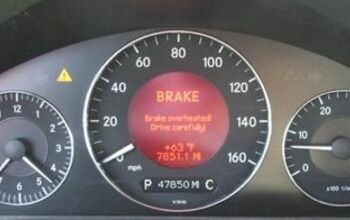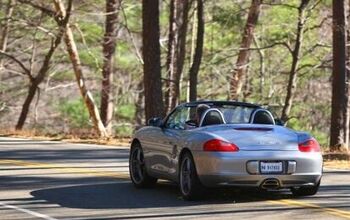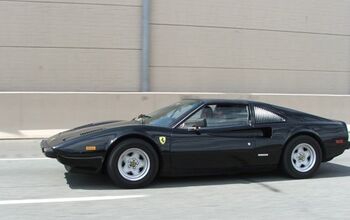Maximum Street Speed Explained, Part II

The über-wealthy have many fascinating ways to speed on America’s highways, from night-vision goggles to convenient spotter planes overhead. But those of us who toil in the middle class have to earn our velocity by hard graft. Freeway speeding is the crack cocaine of fast-road driving—cheap, easy, addictive, and deadly—and nighttime freeway speeding is both more glamorous and annoying than its daytime counterpart.
Once the sun goes down, we can do a lot more of that left-lane passing which is so near and dear to the hearts of wannabe Europeans, thanks to a trick I call “Poor Man’s Takedown.” Cop cars have “takedown” lights: high beams which flash alternately. We can simulate the effect as follows: While coming up behind traffic in the left lane, switch to parking lights only. When you are a few hundred feet back, flash your brights three or four times, producing the “takedown” effect. As Billy Dee Williams would say, “It works every time,” primarily because it startles Toyota drivers into yielding the lane before their natural territorial instincts can assert themselves.
We don’t use the shoulder at night unless we have to. Confused deer, abandoned cars, and discarded retreads tend to hide out there. In the event that a lane-changing fellow motorist leaves us with no safe lane choice and no time to slow the car, it’s occasionally possible to simply split the lane on the side away from the lateral direction of the lane change. If you are swift enough with it, you might even keep your mirrors.
The time will come when, despite our best efforts to look ahead, watch brake lights, and use our Valentine Ones, we will be clocked. At this point, we have two useful options. We can pull over and wait for the nice policeman, right there across the road from his clocking point (this will sometimes earn us some goodwill), or we can run.
It isn’t really “running” until the cop is directly behind us with his lights on. That’s a felony, and I advise against it. Until then, it’s merely additional speeding, spiced up with some unwarranted direction-changing. When we decide to perform said additional speeding, we need to absolutely abandon the idea of getting where we were going. That’s no longer important. Instead, we need to perform three important tasks.
Task one is breaking visual contact. As long as the cop can see us, we are toast. So it’s time to boogie. Most police sedans with light bars can’t break 120 mph, so we want to get to that speed or better immediately. We look ahead, not behind, or we will surely drive right into the back of a lane-wandering minivan full of multicultural children stroking crippled kittens and singing “Kumbaya.” We can check our mirrors in the gaps between traffic.
With Task One accomplished, it’s time to multiply possibilities. The police handbooks indicate that fleeing drivers almost always turn right. So we get off the freeway and turn left. If we have enough clear air and we aren’t driving something like a lime green Audi S5 or other memorable car, we can cross the median and join the lawful traffic heading in the other direction. If that’s too much to ask, get off the freeway . . . but do it quickly. We keep our speed up, using the techniques I’ll cover in Part III, and we make multiple direction changes.
After a few of these, it’s time to abandon the whip. We get out of the car and walk away. A gas station is fine for this, a restaurant is better, a car lot is best of all. If you have, ahem, a new Ford Flex, why not drive into a Ford dealership and park in a line of them? Then get away from the car. Guess what? If they can’t prove we were driving the car, we have a fighting chance in court.
If the police manage to catch us, we say we didn’t see them and that we always drive like a maniac. This abject confession of putative stupidity saved, um, a friend of mine from a beating after he led the Ohio Highway Patrol on a 120+ mph chase down Route 71 in a Lotus Seven clone. Sorry, officer! Didn’t see you back there! Gimme the ticket, I’ll sign it!
In cities, we return to the scene of the crime. Police search in an outward circle that expands with time. The one place they won’t be is the place where the search started, so we go there, using left turns. Needless to say, we don’t go speeding with weed, Ecstasy, firearms, or illegal immigrants in the car, because one felony charge at a time is enough.
In Part III, we will learn how to drive back roads at outrageous speeds.
[Click here to read Part I or Part III of the series. Note: as these editorials have triggered some strong emotions, I’ve turned off our no-flaming the website/author policy. Ish. I reserve the right to douse particularly egregious examples, in an entirely first amendment friendly sort of way]

More by Jack Baruth
Latest Car Reviews
Read moreLatest Product Reviews
Read moreRecent Comments
- Redapple2 Love the wheels
- Redapple2 Good luck to them. They used to make great cars. 510. 240Z, Sentra SE-R. Maxima. Frontier.
- Joe65688619 Under Ghosn they went through the same short-term bottom-line thinking that GM did in the 80s/90s, and they have not recovered say, to their heyday in the 50s and 60s in terms of market share and innovation. Poor design decisions (a CVT in their front-wheel drive "4-Door Sports Car", model overlap in a poorly performing segment (they never needed the Altima AND the Maxima...what they needed was one vehicle with different drivetrain, including hybrid, to compete with the Accord/Camry, and decontenting their vehicles: My 2012 QX56 (I know, not a Nissan, but the same holds for the Armada) had power rear windows in the cargo area that could vent, a glass hatch on the back door that could be opened separate from the whole liftgate (in such a tall vehicle, kinda essential if you have it in a garage and want to load the trunk without having to open the garage door to make room for the lift gate), a nice driver's side folding armrest, and a few other quality-of-life details absent from my 2018 QX80. In a competitive market this attention to detai is can be the differentiator that sell cars. Now they are caught in the middle of the market, competing more with Hyundai and Kia and selling discounted vehicles near the same price points, but losing money on them. They invested also invested a lot in niche platforms. The Leaf was one of the first full EVs, but never really evolved. They misjudged the market - luxury EVs are selling, small budget models not so much. Variable compression engines offering little in terms of real-world power or tech, let a lot of complexity that is leading to higher failure rates. Aside from the Z and GT-R (low volume models), not much forced induction (whether your a fan or not, look at what Honda did with the CR-V and Acura RDX - same chassis, slap a turbo on it, make it nicer inside, and now you can sell it as a semi-premium brand with higher markup). That said, I do believe they retain the technical and engineering capability to do far better. About time management realized they need to make smarter investments and understand their markets better.
- Kwik_Shift_Pro4X Off-road fluff on vehicles that should not be off road needs to die.
- Kwik_Shift_Pro4X Saw this posted on social media; “Just bought a 2023 Tundra with the 14" screen. Let my son borrow it for the afternoon, he connected his phone to listen to his iTunes.The next day my insurance company raised my rates and added my son to my policy. The email said that a private company showed that my son drove the vehicle. He already had his own vehicle that he was insuring.My insurance company demanded he give all his insurance info and some private info for proof. He declined for privacy reasons and my insurance cancelled my policy.These new vehicles with their tech are on condition that we give up our privacy to enter their world. It's not worth it people.”


































Comments
Join the conversation
Regardless, this series encourages me to monitor posts at this site regularly. I don't want to miss what's coming next!
If we wanted complete safety, we'd never leave our homes. The roads are already dangerous (thanks largely to inattentive and distracted slowpokes and drunks, not hyper-attentive speeders), and we accept such dangers on a daily basis as a matter of course. Its called "life". Thanks for posting this series. Highly enjoyable.